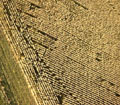Douglass began his KAP experience in 1998, when he visited Emporia State University, Kansas to practice basic KAP methods with J.S. Aber. The success of this venture led to further efforts to develop KAP equipment and techniques suited for crop-scouting applications. Douglass
currently employs a Fujifilm 700 digital camera (1280 by 1024 pixel resolution) and plans to use a 1600x1200 camera soon. A digital camera has the advantage of returning images "instantly" for analysis in the field and quick consultation with farmers. As far as we are aware, this is the first and only use of kite aerial photography for precision agriculture in the country.

| View over the campus of Southeast Community College (SCC) in Beatrice, Nebraska.
Photo © by R. Douglass. |

| Portion of the SCC agricultural program laboratory land, near Beatrice, Nebraska. Notice
the center-pivot irrigation system in upper right portion of this view. Such irrigation systems rotate
around the field in a circular pattern. Photo © by R. Douglass. |

| Autumn view of mature corn crop field. The circular tracks were made by the center-pivot
irrigation system. Green patches are weed infestations. Photo © by R. Douglass. |

| Another view of the same field shown above. Note gaps in the row crop, where the
cultivator inadvertently destroyed some of the crop, missed rows or got out of alignment with rows. Photo © by R. Douglass. |

| Closeup, vertical view of field shown above. Gaps in crop rows are the result of "operator
error," and these spots will produce lower yields. KAP allows quick identification of such problems.
Photo © by R. Douglass. |

| Filley Stone Barn, which is on the National Register of Historic Places, was built in 1873 by Elijah Filley and is located 2 miles south of Filley Nebraska. It is owned and managed by the Gage County Historical Society. On Oct. 17, 1999, the society hosted Filley Stone Barn Days, and this event brought in exhibitors from several states. Photo © by R. Douglass. |


![]() For further information, contact: Rich Douglass.
For further information, contact: Rich Douglass.